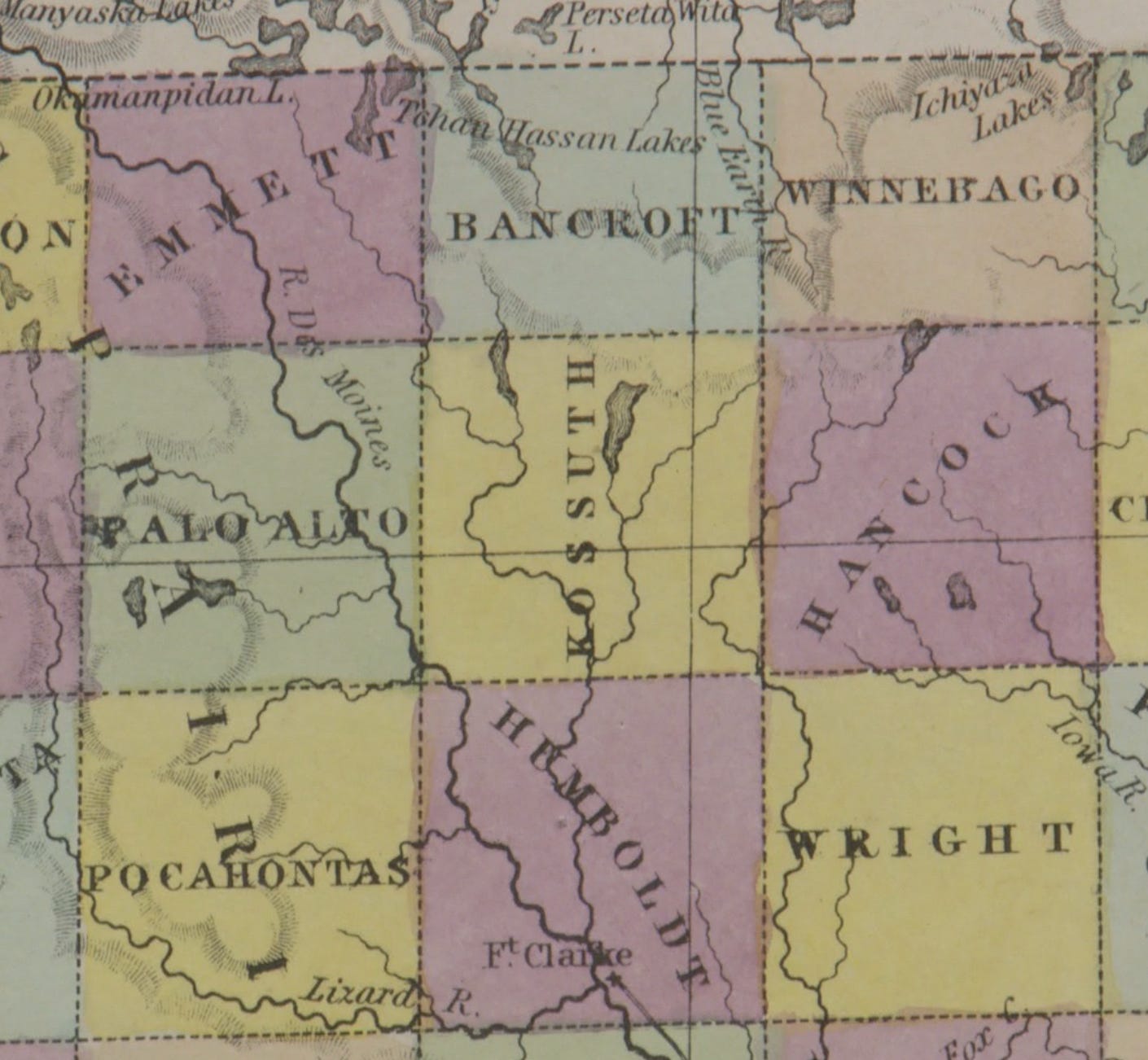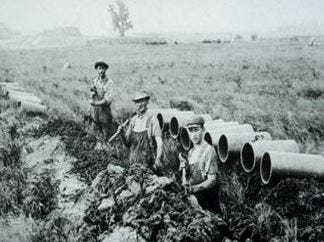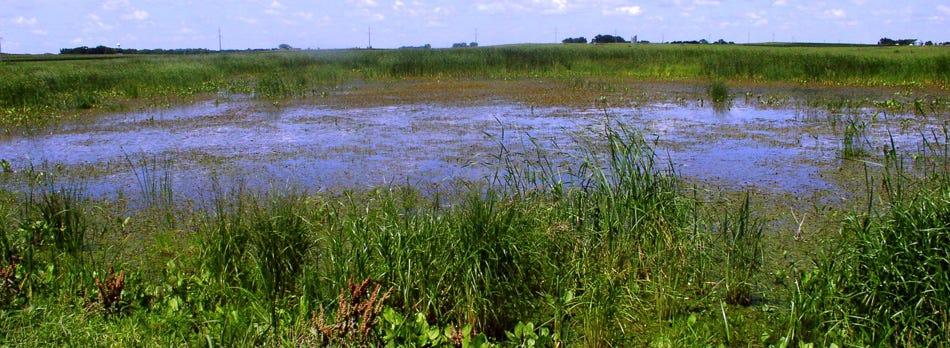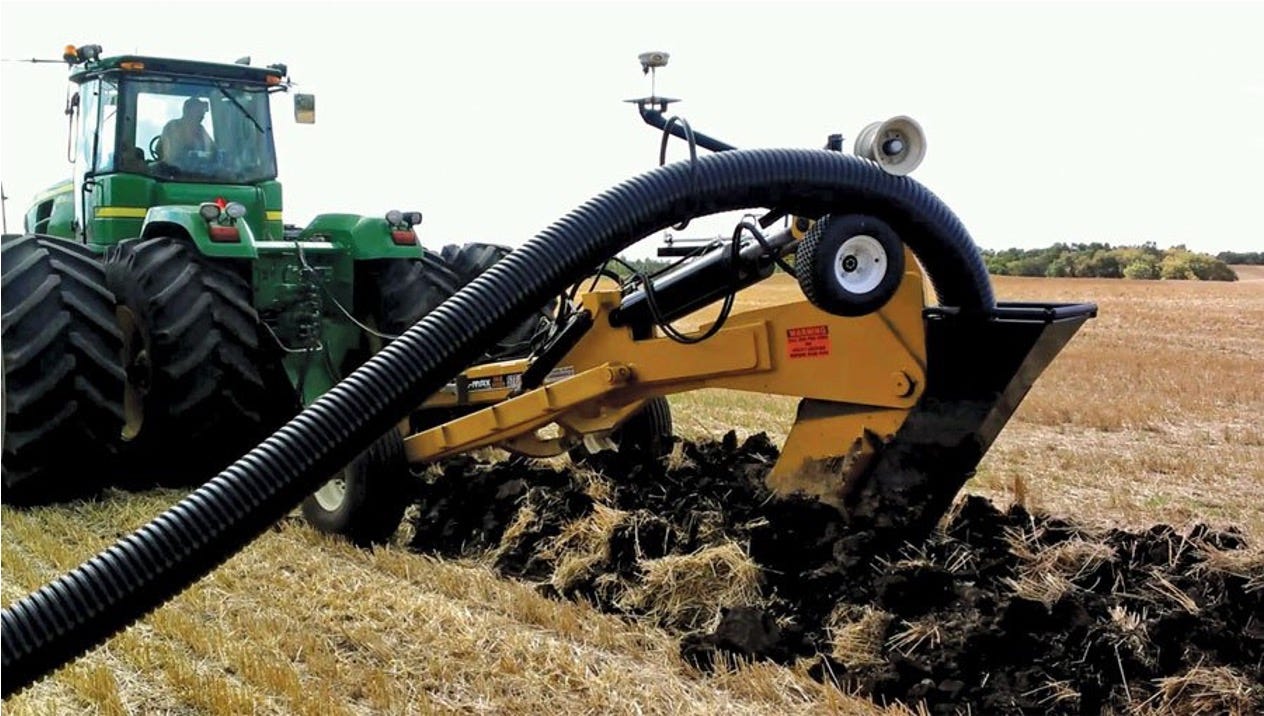Drain Baby Drain
If we're going to rid the land of water, we might as well pollute it as it leaves
Note: About half of what follows was written five years ago but the essay where it rested didn’t make the cut for my book. I had forgotten about it, but was reminded of it recently on two occasions. The first was a conversation I had with Bob Leonard and Steve Semken; the second was when I read an essay written by Ames native and ISU grad John Madson, one of the best writers our state has produced. As a result, I reworked my piece and here it is. The title is meant to echo Sarah Palin’s “Drill Baby Drill” tripe of many years ago.
The best short history of Iowa farming has to be The Landscape of Capitalism by former University of Iowa professor Robert F. Sayre (1933-2014). I read Sayre’s essay many years ago and had all but forgotten it, but it was returned to my memory by a conversation I had with an ag drainage engineer. Did you ever hear that joke about ag drainage engineers? No, of course you didn’t, because there are no jokes about people who wipe out entire ecosystems.
Sayre describes in the essay how the wetlands of Iowa, Illinois, Indiana, Michigan, Minnesota and Ohio once covered an area larger than Lakes Superior, Huron, and Michigan combined. Well over 90% of this wetland area has been drained for agriculture and this figure is greater than 97% in Iowa.
Maybe you’ve wondered why Iowa has 99 counties and not 100. Well, one hundred it would have been, had Bancroft County not been merged into Kossuth County by the legislature in 1857. So much of the county was beneath wetlands that the legislature at the time considered it uninhabitable.
Drainage of wetlands and lakes and an overall lowering of the water table happened gradually from 1850 to 1950 and was achieved by networks of underground drainage pipes (tiles) and constructed ditches. A task this great required much more capital than what early farmers had (many had almost nothing). Thus, much of the earliest drainage was financed by large capital investors from the East coast and England who then sold off individual tracts of the “improved land” to smaller farmers. Sayre wrote that the draining of the prairies could be considered one of the great achievements of American private capital.
He also wrote that nothing else better illustrates the conflict between economics and ecology. At least from the perspective of crop production, drainage was wildly successful from the very beginning. In the 1920s, William Berry, a professor of what was to become the University of Northern Iowa, wrote that drained land generated a surplus of grain and “has so upset farming conditions as to threaten the foundations of agriculture” as farmers struggled through low prices and the farm depression of that decade (1). Agriculture’s inability to align this increased production capacity with demand was the biggest driving force behind the impoundment of the Upper Mississippi River in the 1930s, resulting in the lock and dam system we see today so farmers could get grain out of the US Midwest (2).
Many people ask me if tile drainage affects flooding. The short answer is probably not much, at least within the context of large floods like 1993 and 2008. There is evidence that tile may modestly reduce peak flows in some situations. Sloan et al. (3) stated “For very large storm events, the rainfall magnitude and intensity is so high that surface runoff dominates, irrespective of the antecedent conditions created by the tile drains”, essentially saying tile drainage has no effect in these situations.
Tile drainage does appear to substantially increase total stream flow over the course of a year. Schilling and Helmers (4) found that tile drainage “increases annual baseflow (flows between rainstorms) in streams, with seasonal increases primarily in the late spring and summer months. Thus, tile drainage… may have been a significant contributor to increasing baseflow in Iowa’s streams over the 20th century.” Other research in Iowa and Minnesota has shown much the same thing, with tile increasing annual flows 30-50% over the last century.
This increased baseflow component is especially important for water quality since this is the hydrological driver of stream nitrate. We’ve known this in Iowa since at least 1975 (5) and probably long before that. Nitrate-nitrogen is an important driver of the Gulf of Mexico dead zone and impairment of water resources and drinking water in Iowa. Our state policies have at times recognized the threat to drinking water and about $16 million has been spent closing ag drainage wells, which were designed long ago to direct tile water downward to underground aquifers, a practice we eventually realized was contaminating rural well water (duh). Those high nitrate discharges are now directed out to streams like the Raccoon and Des Moines Rivers which of course are municipal supplies for downstream cities. Call it the war against urban Iowa.
Collectively the pothole wetlands that dotted the northern 2/3 of Iowa were nature in its most euphoric state, Edenic nurseries for countless species of birds, reptiles and amphibians. We drained them all for farming, although today these drained patches tend to have lower (in some cases, much lower) crop yields than the surrounding land. But, like a meandering a stream, they’re an annoyance when maneuvering farm equipment around a field, especially in the present day when 54-row planters march across north central Iowa. So, all those ducks had to find somewhere else to live. Or die.
What makes this all the more maddening is the taxpayer helped farmers drain this land. Iowa outdoor writer John Madson wrote this in 1961 (6): Since 1943, well over a million acres of wetlands have been drained in the upper Midwest with the aid of federal funds. Under a federal drainage program, a farmer can apply for aid and be paid on the basis of the number of cubic yards removed from ditches. This subsidy runs as high as 50%--a strong incentive for a farmer to drain a marsh or pothole on his land. In addition, the government provides all the valuable and necessary engineering and planning free of charge. Of the 1.4 million prairie potholes in the upper Midwest, more than 350,000 have been eliminated through federal subsidy payments. From 1940 to 1953, almost 1.7 million acres of wetlands were destroyed with the aid of taxpayers’ money.”
Nowadays we don’t pay farmers to drain, although be assured they want us to. Instead, your tax dollars are used to entice farmers to build wetlands through the USDA CREP wetland program. So we paid them to drain the wetlands, and now we’re trying to pay them to reconstruct a few. FUBAR, as Tom Hanks said.
According to Sayre, a few folks did object to the first drainage on ecological grounds and drainage advocates attacked them as “enemies of progress,” and indeed Iowa farmers have been more inspired by potential wet weather than Noah. Aerial imagery examined during my time at the University of Iowa showed thousands of miles of new drainage tile added every year to the 2 million miles thought to already crisscross Iowa. Of all the criticisms of the Iowa nutrient reduction strategy, this is perhaps its most overlooked weakness: how on earth can we solve the nitrate problem when we continue to expand its delivery pathway linking farmed fields to the stream network? As we try to improve Iowa streams through cost-share programs that target nitrate loss, we also are charging full speed ahead expanding and enlarging the infrastructure that we know helps drive the problem in the first place. And make no mistake—the continued expansion of the drainage network is not driven by the well-being of the land or the need of the world for food, but rather by the need of owners of capital to increase it.
Our century-old policies have regarded water as a public nuisance and only dry farm land as economically beneficial. The problem we have here is that this has been a zero-sum game when it comes to native species, the environment and our drinking water. Is there a limit to what we can squeeze out of this place called Iowa? I don’t know the answer to that question, but I do know that we are trying really hard to find out.
Note on Madson: Many of today’s environmentalists might have a problem with John Madson, and he with them. In fact, he said that “few people are more tedious than a solemn, zealous environmentalist who’s aflame with righteousness.” But he had great respect for “thoughtful, experienced men and women who have paid their dues with years of outdoor mileage.” Madson was credited by the publisher of many of his books (University of Iowa Press) as "the father of the modern prairie restoration movement." Madson hated that Iowans had been robbed of nature for the sake of enriching a greedy few

The Iowa Writers’ Collaborative Roster
Nicole Baart: This Stays Here, Sioux Center
Ray Young Bear: From Red Earth Drive, Meskwaki Settlement
Laura Belin: Iowa Politics with Laura Belin, Windsor Heights
Tory Brecht: Brecht’s Beat, Quad Cities
Dartanyan L. Brown : My Integrated Live, Des Moines
Jane Burns, The Crossover, Des Moines
Dave Busiek, Dave Busiek on Media, Des Moines
Iowa Writers Collaborative, Roundup
Steph C : It Was Never a Dress, Johnston
Art Cullen, Art Cullen’s Notebook, Storm Lake
Suzanna de Baca, Dispatches from the Heartland, Huxley
Debra Engle: A Whole New World, Madison County
Daniel P. Finney, Paragraph Stacker, Des Moines
Arnold Garson: Second Thoughts, Okoboji and Sioux Falls
Julie Gammack: Julie Gammack’s Iowa Potluck, Des Moines and Okoboji
Fern Kupfer and Joe Geha: Fern and Joe, Ames
Jody Gifford: Benign Inspiration, West Des Moines
Rob Gray's Area: Rob Gray’s Area, Ankeny
Become Inspired... Nik Heftman, Iowa
Beth Hoffman: In the Dirt, Lovilla
Iowa Capital Dispatch, an alliance with IWC
Black Iowa News: Dana James, Iowa
Chris Jones: Chris’s Substack, Iowa City
Pat Kinney : View from Cedar Valley, Waterloo
Robert Leonard : Deep Midwest: Politics and Culture, Bussey
Letters From Iowans, Iowa
Darcy Maulsby : Keepin’ It Rural, Calhoun County
Hola Iowa : Iowa
Alison McGaughey : The Inquisitive Quad Citizen, Quad Cities
Kurtis Meyer : Showing Up, St. Ansgar
Vicki Minor: Relatively Minor, Winterset
Wini Moranville : Wini’s Food Stories, Des Moines
Jeff Morrison : Between Two Rivers, Cedar Rapids
Kyle Munson : Kyle Munson’s Main Street, Des Moines
Jane Nguyen : The Asian Iowan, West Des Moines
John Naughton : My Life in Color, Des Moines
Chuck Offenburger : Iowa Boy Chuck Offenburger, Jefferson and Des Moines
Barry Piatt : Piatt on Politics Behind the Curtain, Washington, D.C.
Dave Price : Dave Price’s Perspective, Des Moines
Ice Cube Press: The Pulse of A Heartland Publisher, North Liberty
Macey Shofroth : The Midwest Creative, Norwalk
Larry Stone: Listening to the Land, Elkader
Mary Swander : Mary Swander’s Buggy Land, Kalona
(1) Berry, William J., 1927. The influence of natural environment in North-Central Iowa, Iowa Journal of History and Politics, 25, 290-305.
(2) Anfinson, J.O., 2003. The river we have wrought: a history of the upper Mississippi. U of Minnesota Press.
(3) Sloan, B.P., Mantilla, R., Fonley, M. and Basu, N.B., 2017. Hydrologic impacts of subsurface drainage from the field to watershed scale. Hydrological processes, 31(17), pp.3017-3028.
(4) Schilling, K.E. and Helmers, M., 2008. Effects of subsurface drainage tiles on streamflow in Iowa agricultural watersheds: Exploratory hydrograph analysis. Hydrological Processes: An International Journal, 22(23), pp.4497-4506.
(5) Baker, J.L., Campbell, K.L., Johnson, H.P. and Hanway, J.J., 1975. Nitrate, Phosphorus, and Sulfate in Subsurface Drainage Water 1. Journal of Environmental Quality, 4(3), pp.406-412.
(6) Madson, J., 1998. Stories from Under the Sky. University of Iowa Press.









One of John Madson’s treasures is Stories From Under The Sky, ISU Press, 1961.
Madsen is a forgotten treasure. Turns out all our ducks are not in a row, but another old saying comes to mind: " 'Play ducks and drakes with': Trifle with; treat frivolously. Also to behave recklessly; to idly squander one’s wealth."